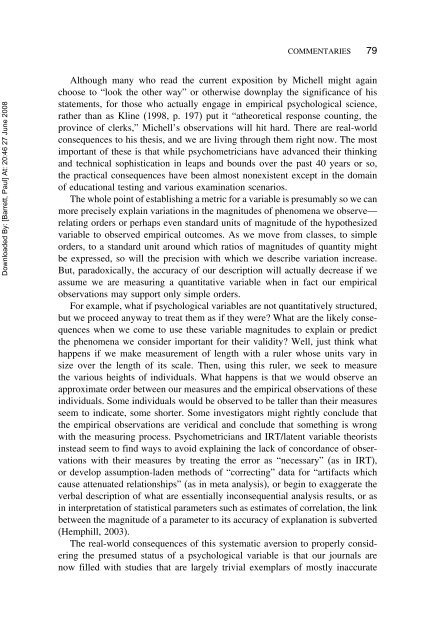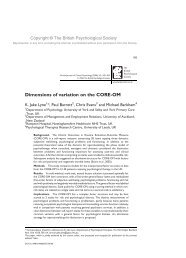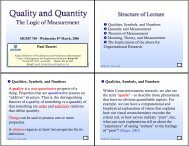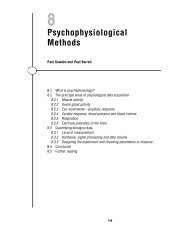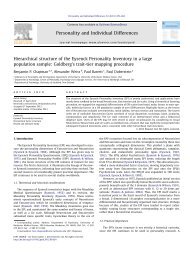95 - Paul Barrett
95 - Paul Barrett
95 - Paul Barrett
Create successful ePaper yourself
Turn your PDF publications into a flip-book with our unique Google optimized e-Paper software.
COMMENTARIES 79Downloaded By: [<strong>Barrett</strong>, <strong>Paul</strong>] At: 20:46 27 June 2008Although many who read the current exposition by Michell might againchoose to “look the other way” or otherwise downplay the significance of hisstatements, for those who actually engage in empirical psychological science,rather than as Kline (1998, p. 197) put it “atheoretical response counting, theprovince of clerks,” Michell’s observations will hit hard. There are real-worldconsequences to his thesis, and we are living through them right now. The mostimportant of these is that while psychometricians have advanced their thinkingand technical sophistication in leaps and bounds over the past 40 years or so,the practical consequences have been almost nonexistent except in the domainof educational testing and various examination scenarios.The whole point of establishing a metric for a variable is presumably so we canmore precisely explain variations in the magnitudes of phenomena we observe—relating orders or perhaps even standard units of magnitude of the hypothesizedvariable to observed empirical outcomes. As we move from classes, to simpleorders, to a standard unit around which ratios of magnitudes of quantity mightbe expressed, so will the precision with which we describe variation increase.But, paradoxically, the accuracy of our description will actually decrease if weassume we are measuring a quantitative variable when in fact our empiricalobservations may support only simple orders.For example, what if psychological variables are not quantitatively structured,but we proceed anyway to treat them as if they were? What are the likely consequenceswhen we come to use these variable magnitudes to explain or predictthe phenomena we consider important for their validity? Well, just think whathappens if we make measurement of length with a ruler whose units vary insize over the length of its scale. Then, using this ruler, we seek to measurethe various heights of individuals. What happens is that we would observe anapproximate order between our measures and the empirical observations of theseindividuals. Some individuals would be observed to be taller than their measuresseem to indicate, some shorter. Some investigators might rightly conclude thatthe empirical observations are veridical and conclude that something is wrongwith the measuring process. Psychometricians and IRT/latent variable theoristsinstead seem to find ways to avoid explaining the lack of concordance of observationswith their measures by treating the error as “necessary” (as in IRT),or develop assumption-laden methods of “correcting” data for “artifacts whichcause attenuated relationships” (as in meta analysis), or begin to exaggerate theverbal description of what are essentially inconsequential analysis results, or asin interpretation of statistical parameters such as estimates of correlation, the linkbetween the magnitude of a parameter to its accuracy of explanation is subverted(Hemphill, 2003).The real-world consequences of this systematic aversion to properly consideringthe presumed status of a psychological variable is that our journals arenow filled with studies that are largely trivial exemplars of mostly inaccurate


